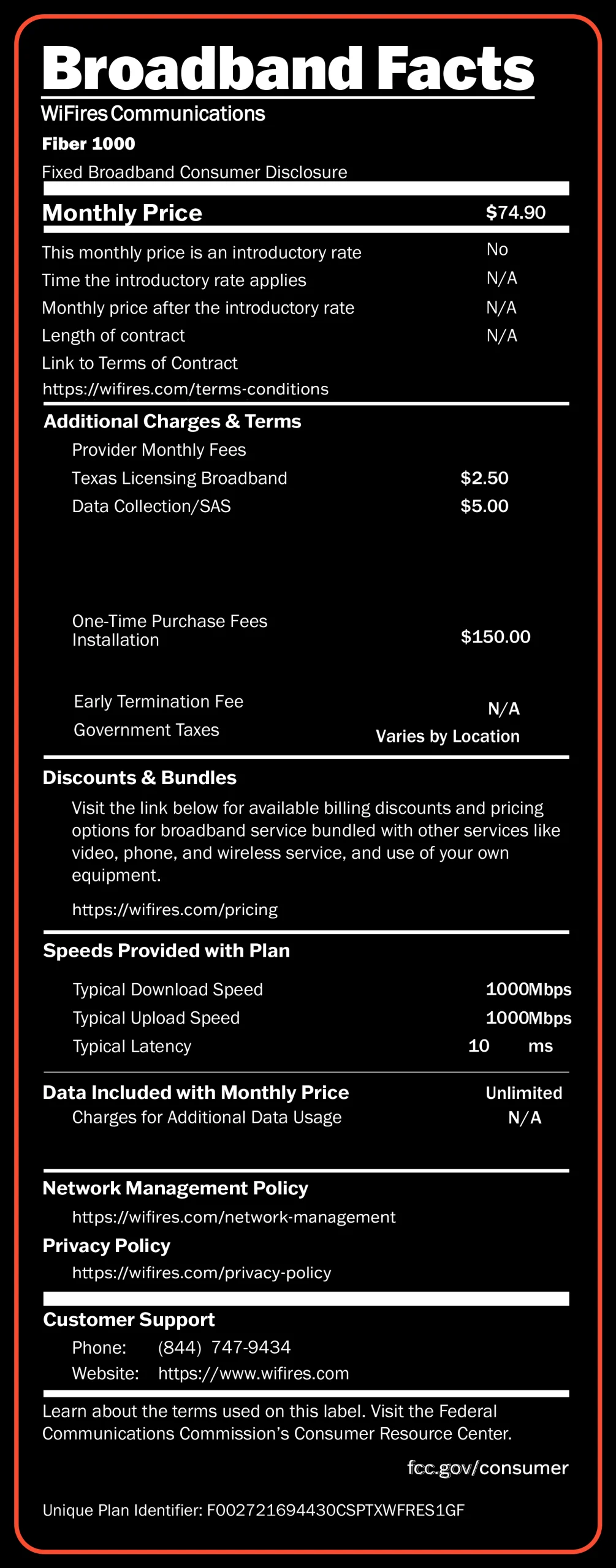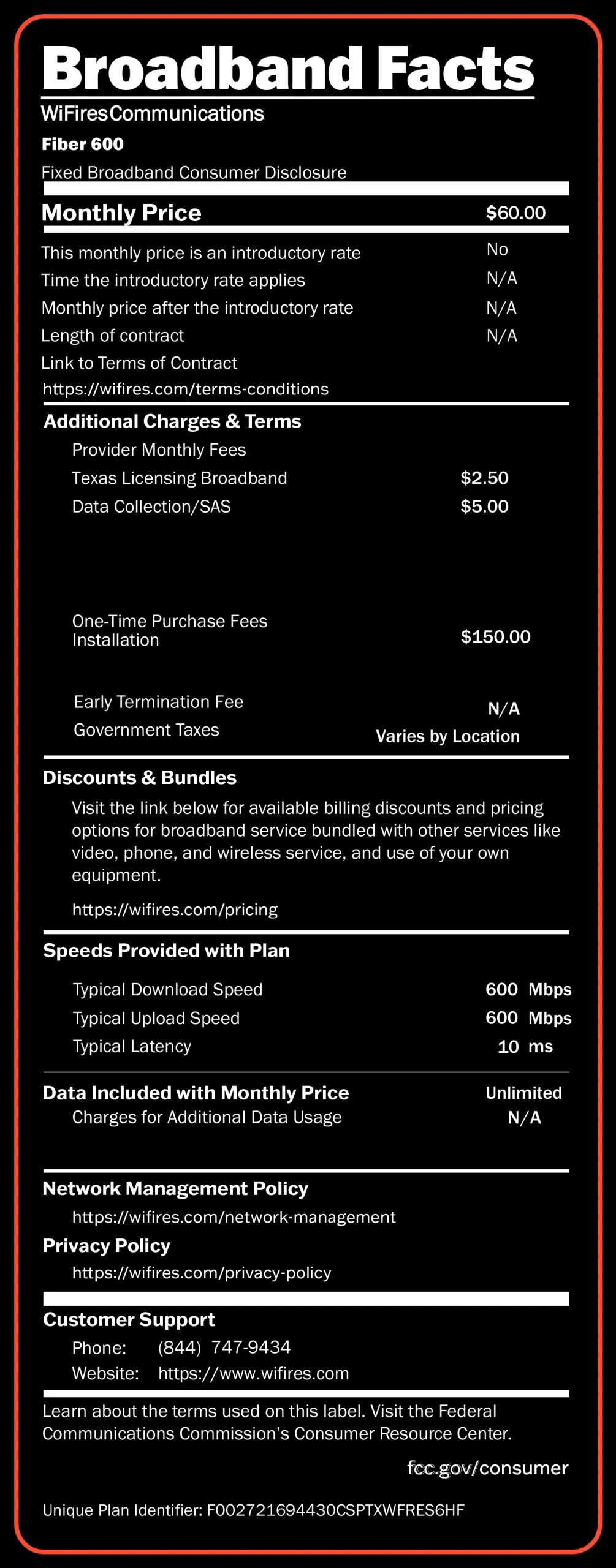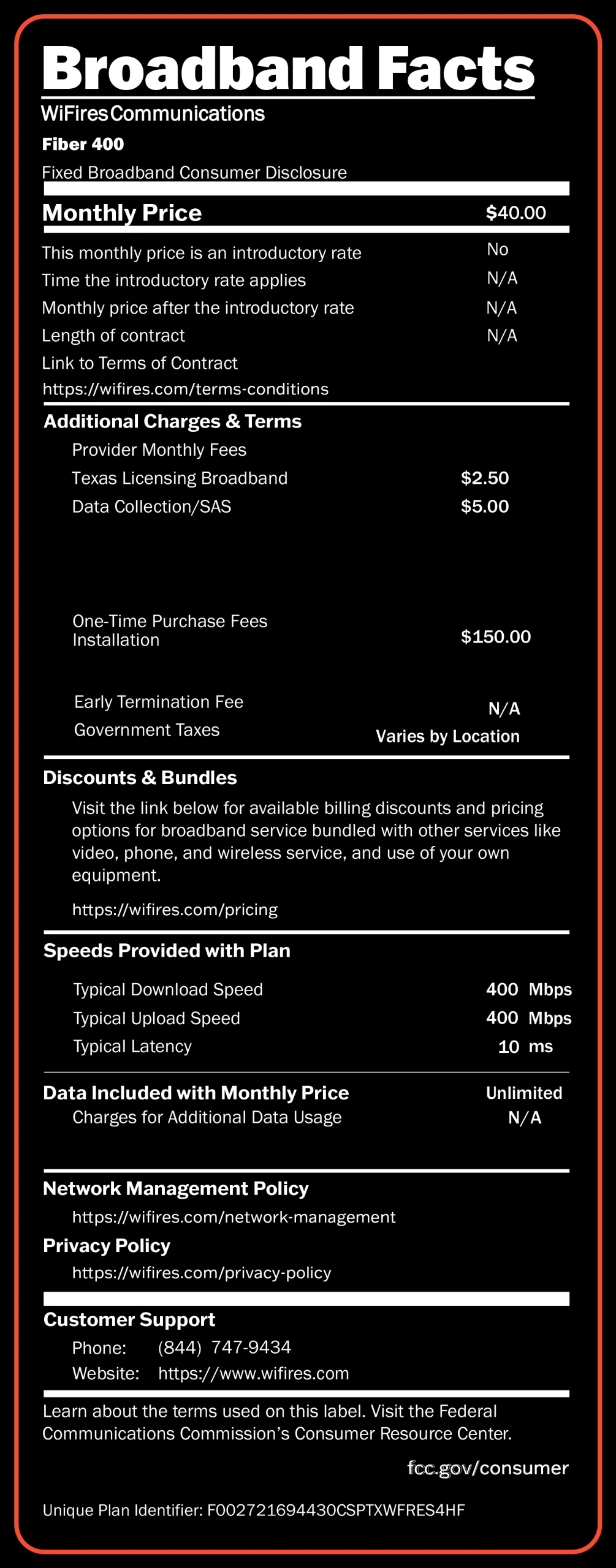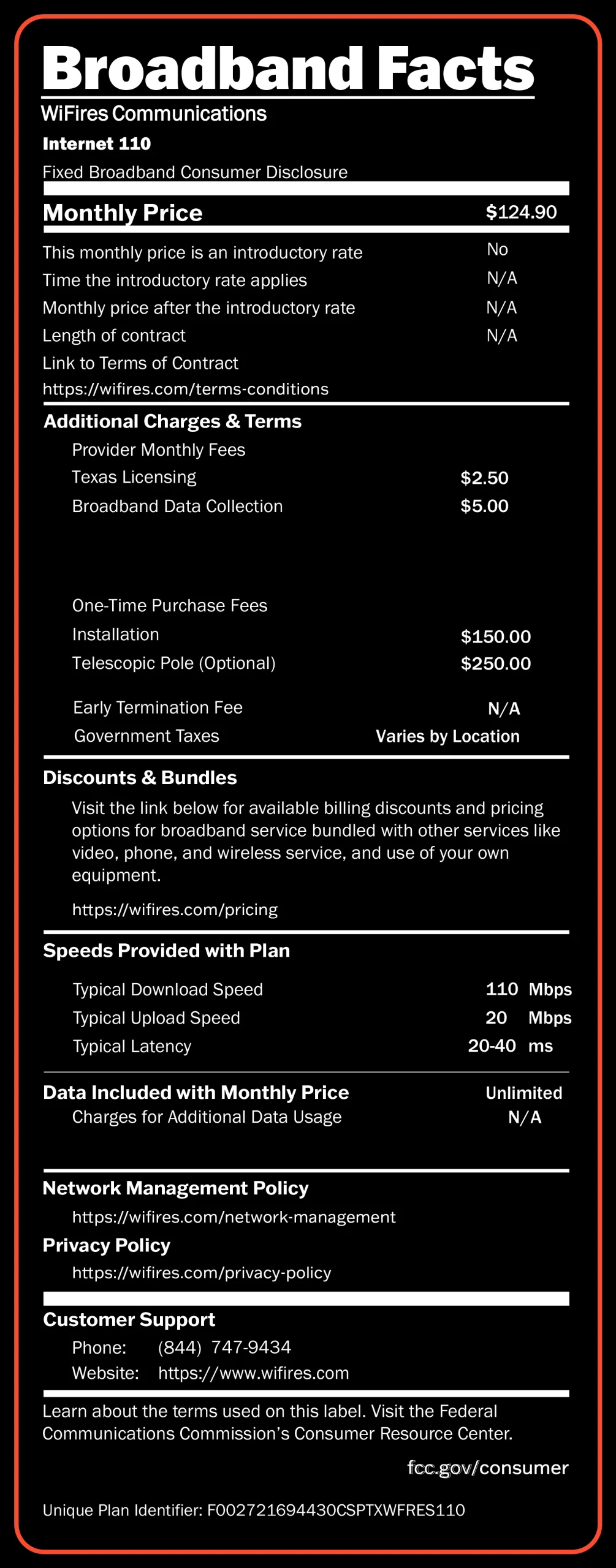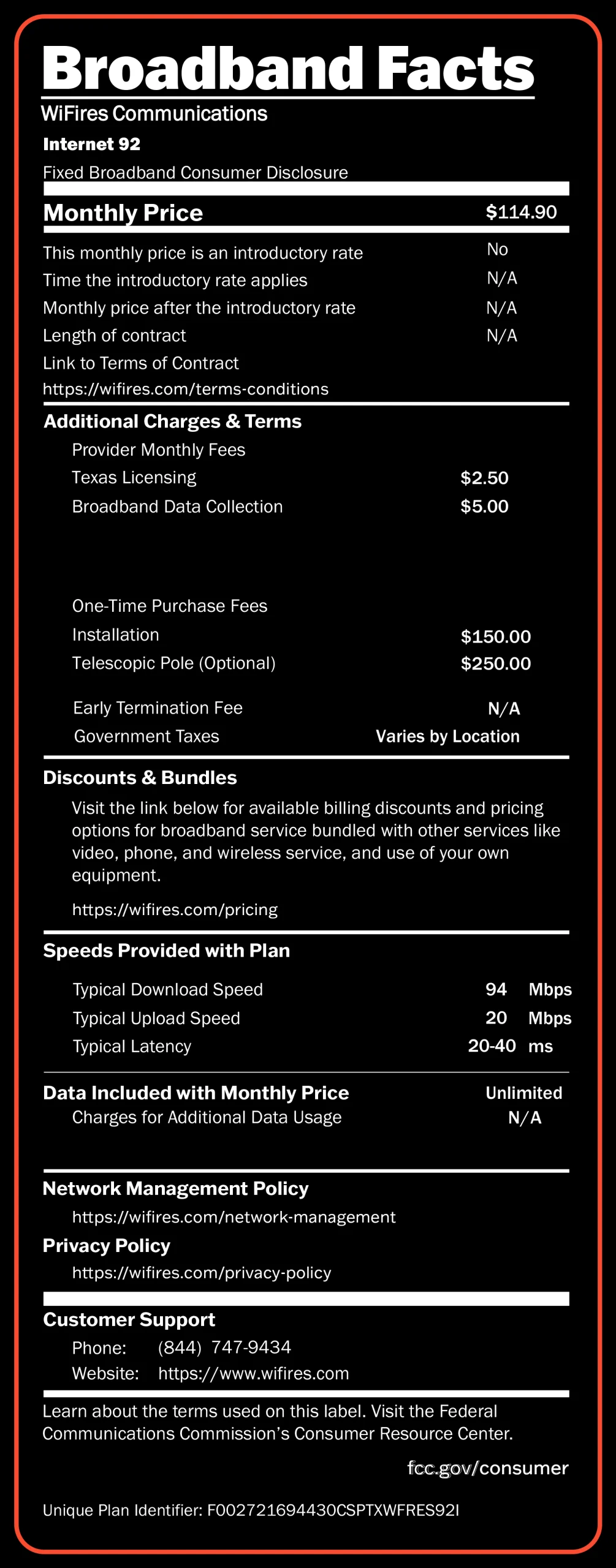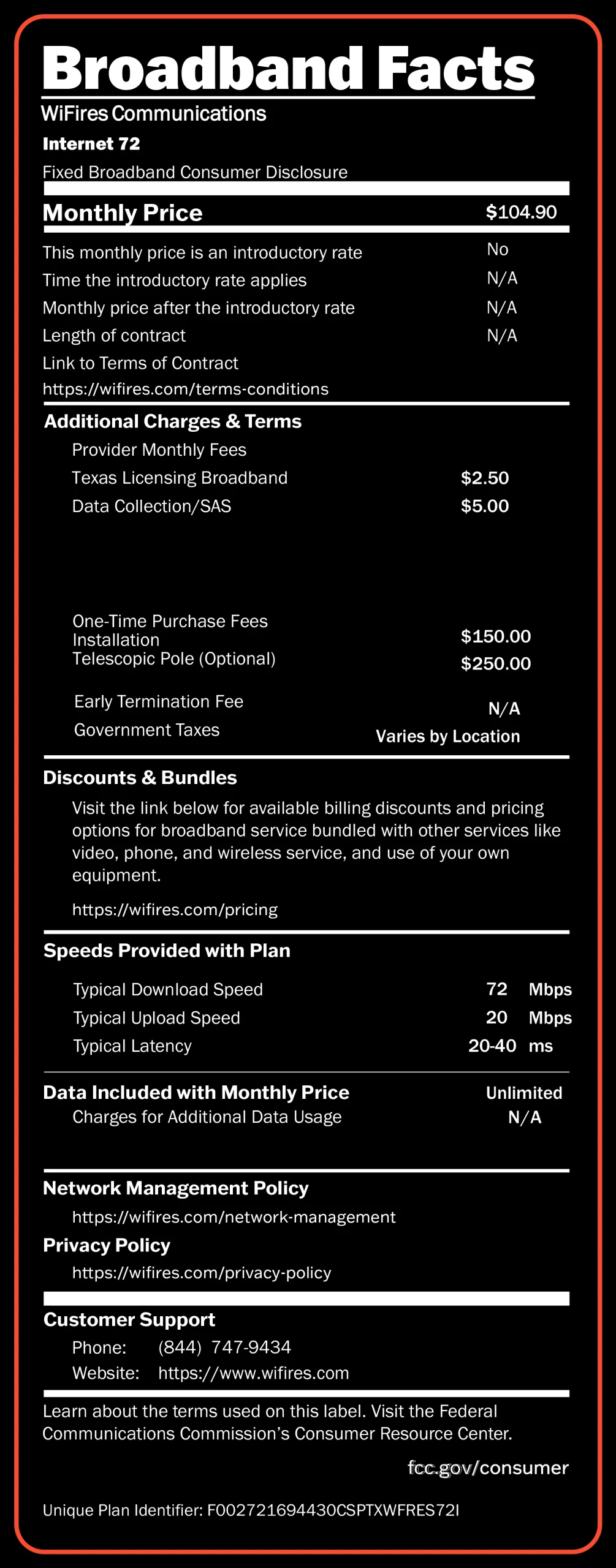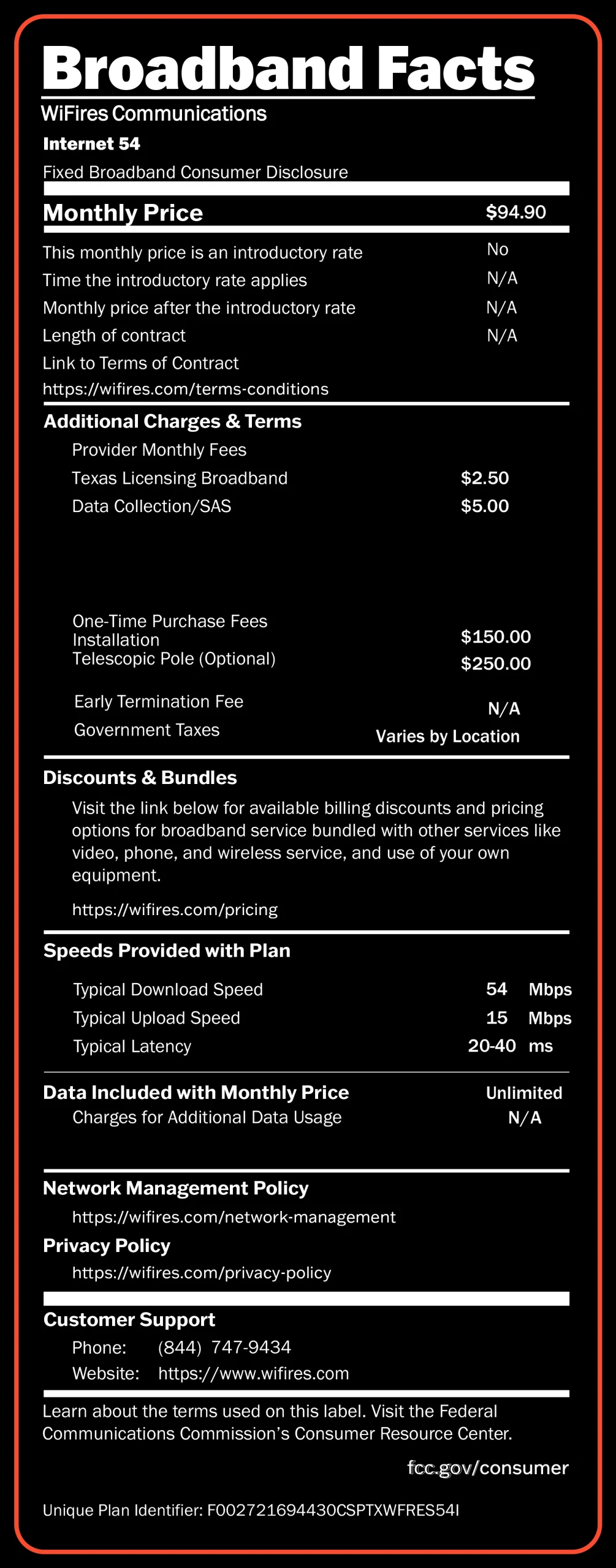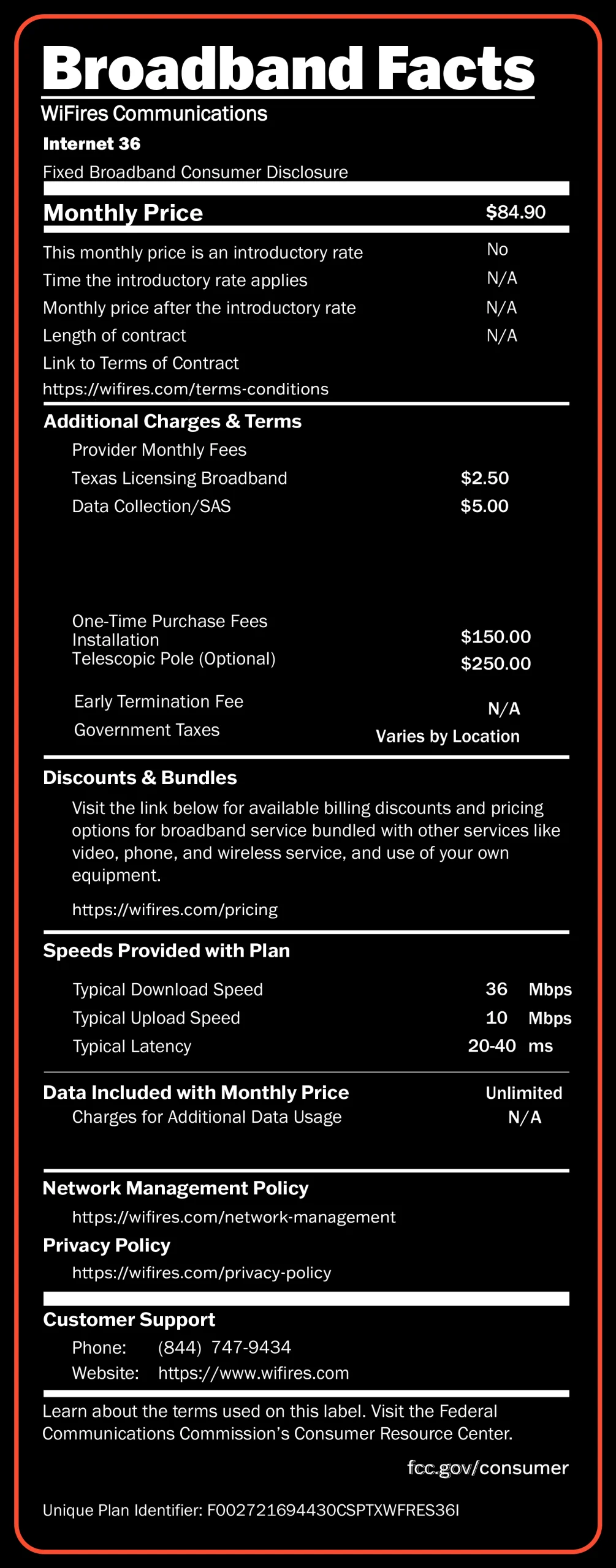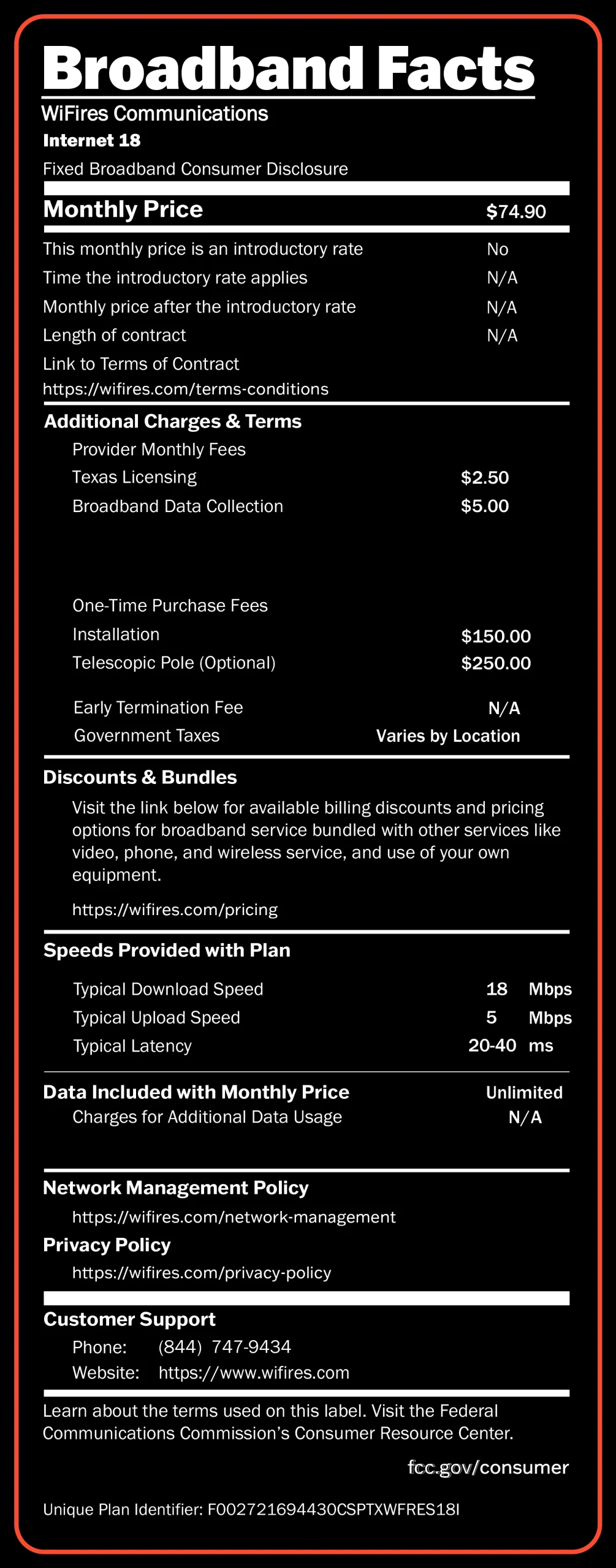In consideration of the terms, conditions and covenants listed above in this contract (the “Contract”), the Customer (as indicated above) and WiFires LLC. agree as follows:
PURPOSE: The Customer wishes to enter into a recurring contract with WiFires for the provision of Internet service (“Services”) for the above-listed Service Address (the “Property”). In order to provide Services to the Property, WiFires may install certain equipment and wiring at the Property.
TERMS: The Customer agrees that the term of this Contract starts on the date WIFIRES activates the Services and continues for the Initial Term.The Customer further agrees that the Contract shall automatically renew and continue for successive terms of one year (“Extension Terms”), unless Customer provides 30-day written notice to WIFIRES prior to the expiration of the Initial Term or any Extension Term, via email (billing@getWiFires.com), or mail to WiFires LLC., 34 Clarksville Paris,Texas 75460, or the address WiFires may designate from time to time.All WiFires accounts require a 30 day notice.This is to include all month to month accounts and all term accounts.
EARLY TERMINATION CONTRACT: In consideration for the Services, Customer has received benefits, sometimes including but not limited to reduced monthly service fees. Accordingly, upon early termination of the Contract during the Initial Term or during Extension Terms, Customer shall pay EIGHTY PERCENT (80%) of the remaining Monthly Recurring fees for the current term, a sum of which the Customer agrees represents a reasonable approximation of WiFires damages for early termination and is not a penalty or forfeiture. WiFires damages in the case of early termination include, but are not limited to, equipment; service and infrastructure costs not reimbursed by designated fees, as well as lost profits, all of which are impractical or extremely difficult to fix with specificity or accuracy.Customer must provide notice of early termination in writing to WiFires via email (billing@getWiFires.com), or mail to WiFires Communications, LLC., 34 Clarksville Paris, Texas 75460, or the address WIFIRES may designate from time to time.
CREDIT CARD AUTHORIZATION: Billing – Customer authorizes WiFires to charge Customer’s credit card for the Services, and any and all charges due to WiFires under the Contract, including any applicable early termination fees. WiFires will provide Customer with an itemized monthly statement by email describing all charges. If the Customer requests monthly statements via U.S. mail, then WiFires shall add a $5.00 monthly fee for such service, in addition to the Monthly Recurring rate in this Contract. In the event Customer’s credit card, or other method of payment, fails to provide payment to WiFires for any reason, Customer shall remain liable for amounts due under this Contract, and shall provide another card or method of payment to WiFires.
PAYMENT: The installation fee and the first months service fee are due once the Services are activated. Payment may be made by credit card, debit card or check. Recurring monthly payments will be debited monthly using the debit card or credit card on file. Mailed invoices will be $5.00 in addition to monthly services fees.
INSTALLATION FEES: Customer shall pay for any installation fee(s) listed in this Contract.
SERVICE FEES: The Customer agrees to pay the monthly fee indicated above (“Monthly Recurring Rate”) for each month of Service. All payments are due 10 days after invoice date when paying by check or due upon receipt if paying by credit card.All payments received 5 days past due date will be considered late and subject to a $10 late fee.All accounts shut off for non-payment are subject to a reactivation fee of $25.00.
INVOICES: Single prices shown above for bundled Services, or for Services provided at multiple locations, will be allocated among the individual services for the purpose of applying applicable taxes and regulatory fees and also may be divided on the Customer’s invoice by location served.
AUTHORIZATION: Customer authorizes WiFires, its employees, agents and independent contractors (“Authorized Parties”), to enter onto the Property to install and maintain any equipment and wiring necessary for Customer to receive the Services (collectively, “Permitted Equipment”). Customer represents and warrants to WiFires that Customer has full authority to enter into this Contract, without obtaining approval of any other person, and acknowledges that WiFires is relying upon such representation and warranty to proceed with installation of any required Permitted Equipment. Customer agrees to indemnify WiFires for any liability arising out of or in any way connected to acts reasonably performed by WiFires in reliance on Customer’s representations of authority. Additionally, in the event that WiFires arrives on location for the installation of the Permitted Equipment, or activation of the Services, and the Customer does not or did not have the authority to authorize the installation, resulting in WiFires having to remove equipment, relocate its equipment or reschedule the installation, Customer may be subject to a trip charge of ONE HUNDRED SEVENTY DOLLARS ($170.00).
GUARANTEE OF SERVICE: WiFires offers “Asymmetrical”, “Symmetrical” and “Enterprise” plan types.“Asymmetrical” and “Symmetrical” are burstable plans.The upload and download speeds listed in the “Symmetrical” and “Asymmetrical” plan descriptions are Maximum Information Rates (MIRs).The Committed Information Rates (CIRs) for “Asymmetrical” and “Symmetrical” plans are 75% of the Maximum Information Rates (MIRs).The Committed Information Rates (CIRs) for “Enterprise” plans are 100% of the listed Maximum Information Rates (MIR’s). WiFires also offers Tier Levels with support response guarantees for the Committed Information Rates.The details of any applicable service response guarantee may be found in the “Description of Packages” chart, which is available at www.WiFires.com and details the respective onsite and telephone/email response guarantees for each Tier Package.
UPGRADING OR DOWNGRADING SERVICE PLAN LEVELS: The Customer may “Upgrade” to a higher “tier level” of Services at any time during the Contract Term. In order to Upgrade, a new contract must be executed with a minimum new Contract Term of one (1) year, or the period remaining on the original Contract Term, whichever is greater. The Customer may “Downgrade” Symmetrical or Asymmetrical plans to a lower “tier level” of Services only if the Customer has completed at least fifty percent (50%) of the original Contract Term. In order to Downgrade, a new contract must be executed with a minimum new Contract Term of at least one (1) year in addition to the remaining original Contract Term.Enterprise Level Plans and Tier Level Customers receiving a Special Incentive or Promotion may not be downgraded until the original contract term has been completed.If WiFires no longer offers the particular service or tier package utilized by the Customer following the expiration of the Contract Term or any Extension Term, WiFires, in its sole discretion, shall place the Customer in the new service package which most closely approximates the package or tier which the Customer previously utilized.Further, WiFires may change the terms of this Contract, including the above-referenced Monthly Recurring rate with 30 days written notice prior to the expiration of the Contract Term or any Extension Term.
EQUIPMENT RECOVERY: Upon termination of a Service for any reason, WIFIRES or its representative will contact Customer to schedule a mutually acceptable time and date for retrieval of WiFires Equipment located on Customer’s premises. Alternatively, WiFires may request that Customer package WiFires Equipment and return it, at WiFires cost, to a location identified by WiFires. If Customer does not provide WiFires with access to its premises to allow WiFires to recover the WiFires Equipment within thirty (30) days following WiFires contact, or if Customer does not ship the WiFires Equipment to WiFires with the thirty (30) days, then WiFires will charge Customer and Customer shall pay for the replacement cost of such equipment.
MOVING OR TRANSFERRING SERVICE: If Customer moves to a location outside of the WiFires coverage area, Customer shall pay FIVE HUNDRED DOLLARS ($500), or 80% of the remainder of the Monthly Recurring fees payable under the Contract Term, whichever is less, a sum which Customer agrees is less than WiFires damages for early termination but is extended as a courtesy for those who must move locations. If Customer moves to a location inside the WiFires coverage area and cannot receive service due to Line of Sight (“LOS”) issues, Customer will pay the sum of FIVE HUNDRED DOLLARS ($500), or 80% of the remainder of the Monthly Recurring fees payable under the Contract Term, whichever is less, a sum which Customer agrees is less than WiFires damages for early termination but is extended as a courtesy for those who must move locations. In order to receive the reduced early termination fee of FIVE HUNDRED DOLLARS ($500), Customer must reasonably provide requested documentation to WiFires of Customer’s change of address, such as a utility bill.In the event Customer moves locations within WiFires coverage area, Customer shall pay ONE HUNDRED SEVENTY DOLLARS ($170) to transfer the Services to the new location (the “Move Order” fee).
ACCEPTABLE USE POLICY: This Contract is subject to WiFires Acceptable Use Policy (“AUP”), which is incorporated by reference herein and which may be modified from time to time at WiFires sole discretion to improve network conditions, conform to industry standards and respond to legal and economic changes impacting the provision of the Services, as defined below. A copy of the AUP currently in effect may be found at www.WiFires.com/AUP
FILTERING: In the case of excessive bandwidth usage by peer to peer file sharing programs, compromised file servers or abusive packets originating from Customer’s connection, WiFires reserves the right to throttle or shape Customer’s traffic to allow fair network conditions for its customers. All customers should realize this is in the best interest of business class connectivity.
ENTIRE SERVICE AGREEMENT: SEVERABILITY – This Contract sets forth the entire understanding and agreement between Customer and WiFires, and may be changed with written notice where expressly noted. In the event any provision of this Contract is found to be invalid, illegal or unenforceable, the validity, legality and enforceability of any of the remaining provisions shall not in any way be affected or impaired and a valid, legal and enforceable provision of similar intent and economic impact shall be substituted therefore.
CHANGES IN CONTRACT TERMS: We reserve the right to change the terms and conditions on which we offer Service. If we make any such changes, we will send you a copy of your new Customer Agreement containing its effective date.If you elect not to cancel your Service after receiving a new Customer Agreement, your continued receipt of Service constitutes acceptance of the changed terms and conditions. If you notify us that you do not accept such terms and conditions, then we may cancel your Service upon 30 days written notice to you, as we cannot offer Service to different customers on different terms, among other reasons. You will not be responsible for fees for early termination.
LIMITATION OF LIABILITY: The total cumulative liability of WiFires, its employees, officers, directors, representatives and agents (hereinafter collectively called “the WiFires parties”), if any, for costs, losses, or damages from all claims, actions or suits howsoever caused or arising out of or in connection with this agreement shall be limited to direct damages and shall not exceed the greater of: (i) the amount of payments received by WiFires fromcustomer for the twelve months prior to the occurrence of the event(s) giving rise to any claims, actions or suits or (ii) any amounts payable and actually paid to the customer or WiFires, as applicable, under any applicable insurance policies then in effect.In no event shall the WIFIRES parties or any member thereof be liable for any special, consequential, incidental, exemplary, punitive or other indirect damages, for loss of profits, loss of use or loss of data, howsoever caused or arising and regardless of legal theory or foreseeability.No claims may be asserted by either party against the other with respect to any act, event or omission that occurred more than eighteen (18) months prior to such claims, actions or suits being asserted.
ARBITRATION: The parties agree that any disputes between the parties, their employees, their owners, officers or directors shall be resolved by binding arbitration pursuant to the Federal Arbitration Act.The arbitration shall be held in Lamar County, Texas and the arbitrator shall apply the substantive law of Texas, which shall govern this dispute. The parties shall share equally the cost of arbitration.
ATTORNEY’S FEES: If either party brings legal action to enforce or interpret this Agreement, the prevailing party shall be entitled to its reasonable attorney’s fees and costs.
VENUE/ENTIRE AGREEMENT: This Contract supersedes all prior agreements, if any.It can only be changed by a written agreement signed by parties.If any part of this Contract is deemed unenforceable, the remaining portions will continue in full force and effect.A waiver of a breach of any portion of this Contract will not be considered to be a waiver of any future breaches.This Contract will be governed by Texas law and any dispute will be venued in Lamar County, Texas.
844-747-9434
